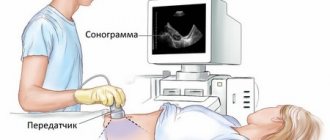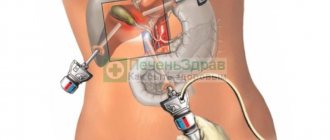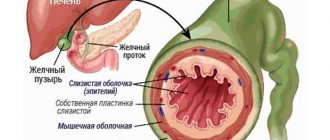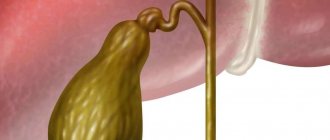Gallbladder cancer is a malignant tumor (usually adenocarcinoma or squamous cell carcinoma) of the gallbladder tissue. Gallbladder cancer occurs with pain in the right hypochondrium, nausea, vomiting, weight loss, and jaundice. When diagnosing gallbladder cancer, data from ultrasound, gallbladder puncture, cholecystography, CT, MRI, ERCP, and diagnostic laparoscopy are taken into account. For the purpose of radical treatment of gallbladder cancer, it is necessary to perform cholecystectomy, resection of the right lobe of the liver, and sometimes pancreaticoduodenectomy.
About gallbladder cancer
Gallbladder cancer is a malignant oncopathology in which the cells of the organ undergo mutational transformations at the molecular level. The disease is diagnosed infrequently - out of the total number of cancers of the digestive system, it is confirmed in 0.5% of cases. The risk group includes women of retirement age (over 55 years old).
The pathology is characterized by rapid development and a severe clinical picture, including intense pain, exhaustion, and jaundice. Difficulties in early detection and successful treatment of the disease are associated with insufficient knowledge of the pathogenetic mechanisms leading to cell mutation.
In most cases, the disease is detected at the stage of distant metastases, when the tumor is no longer operable. It is this circumstance that explains the extremely unfavorable prognosis for the life of patients.
Causes
Gallbladder cancer forms when gallbladder cells mutate their DNA. Mutations cause cells to grow out of control, multiply in an uncontrolled manner, and continue to live when other cells would normally die. The accumulation of abnormal cells creates cancerous tumors.
The reasons are not exactly known. However, some factors are known to significantly increase the risk of developing cancer. It is believed that gallbladder cancer may result from long-term untreated gallstone disease. Bile duct cysts and chronic cholecystitis are also risk factors for cancer.
Gallbladder cancer may also accompany some colon polyposis syndromes. The so-called Porcelain bubble, that is, the one whose wall is saturated with calcium salts.
An increased risk of development is observed among workers in the shoe, rubber, textile and paper industries.
Risk factors:
Risk factors include:
- Old age (especially over 70 years old);
- Female gender (there are 1.5-2 times more women among patients);
- Obesity (increases the risk of pathology of the biliary tract in general, especially in combination with female gender);
- Smoking;
- Occupational hazards (in the rubber industry, metallurgy due to exposure to nitrosamines and other carcinogens);
- Stones and inflammation in the gallbladder (up to 90% of cancer patients suffered from cholelithiasis and/or chronic cholecystitis);
- Calcification (deposition of calcium salts) in the wall of the gallbladder against the background of chronic inflammation significantly increases the likelihood of cancer;
- Bile duct cysts and malformations leading to stagnation of bile, which itself to some extent has carcinogenic properties, against the background of which precancerous changes occur in the mucous membrane of the biliary tract;
- Gallbladder polyps measuring 1 cm or more have a high risk of malignancy;
- The presence of Helicobacter pylori infection increases the risk of ulcerative lesions in the stomach and duodenum, as well as the likelihood of cholecystitis and cholelithiasis, which can cause cancer;
- A diet with a predominance of carbohydrates and fats and a low content of fiber and dietary fiber;
First signs and manifestation
In the early stages of the disease, there are practically no specific signs. As a rule, at this stage of development, gallbladder cancer is discovered completely by accident during a histological examination of tissues removed during cholecystectomy for calculous cholecystitis.
- A tenth of patients have migratory thrombophlebitis (the so-called Trousseau syndrome). With this syndrome, phlebothrombosis is formed in different parts of the body, which is practically untreatable.
- The early period of gallbladder cancer, characterized by the presence of nonspecific manifestations, is often called pre-icteric. At this stage, patients experience a feeling of bloating in the epigastric region, heaviness in the right hypochondrium, various stool disorders, frequent nausea, severe weakness, a state of constant malaise, and sudden weight loss.
- The duration of the pre-icteric period is determined by the localization of the tumor focus and its proximity to the biliary tract. When the tumor process is localized in the tail and body of the pancreas, the pre-icteric period lasts much longer than when its head or extrahepatic ducts are affected.
Is it possible to diagnose a tumor at an early stage?
It is very difficult to detect gallbladder cancer at an early stage. There are no effective tests or screening studies. Most often, early diagnosis occurs by chance, in one of two cases:
- The tumor is detected during an ultrasound, which is initially prescribed for gallstone disease.
- The diagnosis is made after the gallbladder is removed due to gallstones. It is sent for a biopsy and cancer cells are found in the sample.
If you have never had your gallbladder checked before, be sure to get tested, as many gallbladder diseases develop asymptomatically.
Get a free consultation by phone: +7 (495) 104-70-55
Classification
Clinical classification according to the TNM system distinguishes the following stages of gallbladder cancer.
- Tis – preinvasive gallbladder cancer
- T1 – tumor invasion of the mucous (T1a) or muscular layer (T1b) of the gallbladder wall
- T2 – invasion of the gallbladder wall up to the serous layer; there is no infiltration into the liver
- T3 – tumor invasion of the serous membrane with spread to the visceral peritoneum or liver (depth of invasion up to 2 cm)
- T4 – invasion into the liver to a depth of more than 2 cm or invasion into other organs (stomach, duodenum, colon, omentum, pancreas, extrahepatic bile ducts).
- N0 – metastatic lesion of regional lymph nodes is not detected
- N1 – there is damage to the lymph nodes of the common and paravesical bile duct or the porta hepatis
- N2 – metastases to the lymph nodes of the duodenum, head of the pancreas, portal vein, superior mesenteric or celiac arteries.
- M0 – distant metastases are not detected
- M1 – distant metastases of gallbladder cancer are determined.
Depending on the histological structure of the neoplasm, there are:
- Adenocarcinoma;
- Squamous cell oncology;
- Solid cancer;
- Scirrhoz;
- Low differentiated.
Cancer can be localized, when the location of the tumor is clearly defined, and inoperable—the neoplasm migrates to neighboring organs, making removal impossible.
Stages of development
The test results will show whether you have a tumor. They will show where the primary cancer is (carcinoma) and whether the cancer cells have spread to other parts of your body (called metastasis). This helps doctors “stage” the disease so that the best therapy can be selected.
The staging system used for gallbladder cancer is known as the "TNM system" (T = tumor, N = nodes, M = metastasis).
- T followed by a number from 1 to 4 describes how far the carcinoma has spread into the liver and nearby tissues. A higher number after the T (such as T3 or T4) means it has spread further.
- N plus a number from 0 to 3 describes whether the cancer has spread to the lymph nodes near the liver and, if so, the number of cancers in the nodes. Higher numbers are used for nodes that are more affected by cancer.
- An M followed by a 1 indicates that the carcinoma has spread to other organs or lymph nodes that are not near the liver. M0 means there is no sign of cancer spreading.
Doctors combine this information to determine the stage of the cancer, from stage 1 (I) to stage 4 (IV). For example, a cancer graded T1, N0, M0 (tumor contained in the liver, no lymph nodes involved and no metastasis) would be called stage I cancer.
The lower the number stage, the less widespread the cancer and the easier it is to treat.
initial stage
This stage is more often called pre-icteric. The patient is already experiencing problems with peristalsis, bloating and weakness are often observed. Nausea occurs, appetite disappears, weight decreases.
How long the initial stage will last directly depends on the place where the tumor begins to grow. The closer to the head of the pancreas or extrahepatic ducts, the faster.
Further development and manifestation
The pre-jaundice period is replaced by the stage of obstructive jaundice. The main reason for its development is the narrowing of the bile ducts, due to which the digestive enzyme does not completely enter the duodenum. The liver grows, gastric emptying becomes constant, the skin turns red and itchy, feces and urine suddenly change color.
Due to partial or complete obstruction of the bile ducts, dropsy, secondary biliary cirrhosis, etc. develop. The patient becomes increasingly lethargic, finds it difficult to concentrate, and the body gradually becomes exhausted.
Severe form
Severe – regional and distant lymph nodes are involved in the pathogenic process. The characteristic signs of the disease at this stage are difficult to ignore, since they lead to a significant deterioration in the person’s condition. Therapy is often aimed at reducing the intensity of symptoms and preventing the spread of the disease. Very often patients become disabled.
Complicated stage
Complicated - cancer cells metastasize to distant organs, namely the abdominal cavity, ovaries, pleura and omentum. Treatment in this case will be only supportive in nature, i.e. it will be aimed at prolonging the patient’s life.
Symptoms and manifestations of gallbladder cancer
In the early stages, gallbladder cancer usually shows no symptoms, but it can sometimes cause pain in the right side above the stomach.
People with gallbladder carcinoma may also have symptoms such as nausea, vomiting, weakness, and yellow skin (jaundice). Other signs include fever, chills, poor appetite and weight loss.
If you have one of these symptoms, it does not mean you have gallbladder carcinoma. Remember that this is a rare disease and your symptom may be caused by something less serious. However, consult a doctor if any symptom persists for more than 2 weeks. Don't delay visiting your doctor if you have signs of jaundice.
Jaundice can either mean that your liver is not working properly or that your bile ducts are blocked. Symptoms may include:
- yellowing of the skin and whites of the eyes;
- severe itching;
- darkened urine;
- Pale-colored stool (stool).
Jaundice is caused by the accumulation of bile salts in the blood. If cancer blocks the common bile duct, bile cannot drain into the intestines as usual. Thus, bile salts accumulate in the blood and tissues of the body. Bile salts make the skin and whites of the eyes yellow.
Almost half of people diagnosed with gallbladder cancer have jaundice. This is often a sign that the cancer is in more advanced stages.











